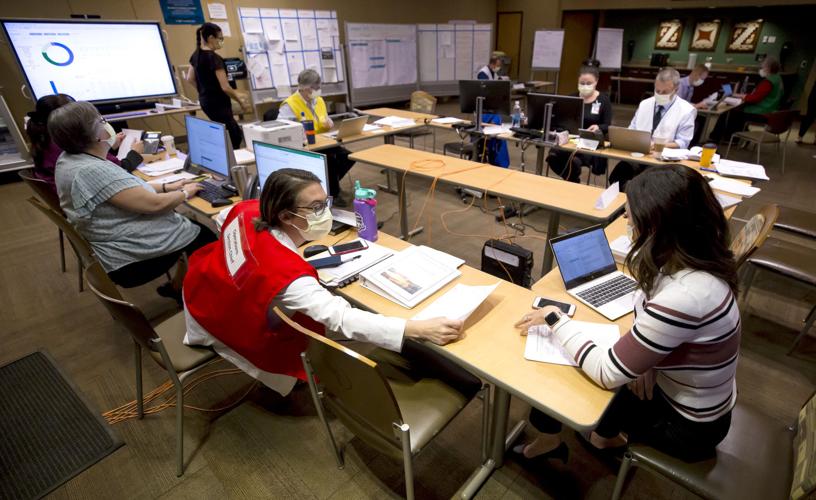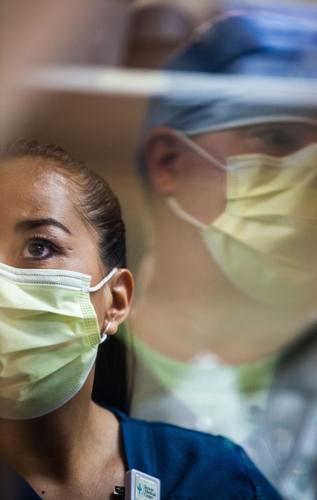The spread of COVID-19 has slowed in Arizona and Pima County since the number of cases peaked in late June, but the risk level remains elevated throughout the state, several data points suggest.
Despite recent improvements in COVID-19 trends, public health experts warn that these trends could easily worsen if Arizonans don’t continue to take the pandemic seriously.
“We are by no extent of the imagination out of the woods,” said Dr. Francisco Garcia, Pima County’s chief medical officer. “We need to continue to double down on our mitigation strategies.”
The number of new, confirmed countywide and statewide COVID-19 cases recently declined again from one week to the next.
A simultaneous decrease in diagnostic testing could have reduced the number of new, confirmed cases, but the percentage of tests turning up positive for COVID-19 also decreased, which suggests the virus may be spreading less, Dr. Joshua LaBaer, executive director of Arizona State University’s Biodesign Institute, said on a conference call Wednesday.
Arizona’s estimated Rt has also been trending down, with a value of .84 as of Thursday, according to the website rt.live. This reflects the reality that transmission of the virus has been somewhat reduced in Arizona, LaBear said.
The Rt measures the average number of people an infected person infects. Infections slow when the Rt is below 1.
Hospital occupancy due to COVID-19 has also decreased, LaBear said. It hasn’t decreased as fast as cases, but that’s no surprise since patients hospitalized for the virus can take a long time to recover.
“My sense of things is that we continue to head in a reasonably positive direction,” he said. “The state is not only stabilized but it’s actually showing a general trend towards a decreased number of positive cases.”
Fewer cases, tests
New confirmed cases statewide totaled 11,311 from July 19 to July 25, according to data published by the Arizona Department of Health Services on Friday. This was a decrease of 6,919 cases, or 38%, from the week of July 12 to July 18. Tests decreased by 29% over the same time period.
Statewide, the percentage of positive cases from July 19-25 was 13%, down from 16% the week before, according to ADHS data.
These metrics could change as more test results from July 19-25 trickle in.
The number of cases and tests for more recent weeks are still very likely incomplete due to data-reporting lags, which make it difficult to interpret recent coronavirus trends.
In Pima County, the number of cases has started to show a “downslope,” while the percentage of positive cases has also declined, Garcia said.
Countywide, new cases totaled 1,020 from July 19 to July 25. This was a decrease of 476 cases, or 32%, compared with the previous week.
The number of countywide diagnostic tests decreased about 26% over the same time period. But Garcia said demand for tests is still high.
The percentage of positive cases in Pima County from July 19-25 was 10%, down from 13% the week before, according to ADHS data published Friday.
Garcia said he won’t be happy until the percentage of positive cases is below 5%. That’s when he will believe there’s both adequate testing and lessened community transmission, he said.
These improvements in COVID-19 trends emphasize the benefits brought by changes in policy a few weeks ago, LaBaer said.
In Pima County, for example, Garcia pointed out that the number of new cases started to decrease shortly after the Pima County Board of Supervisors approved a mask-wearing ordinance on June 19.
These types of mask-wearing laws have helped curb the spread of the virus, but the virus is still spreading.
Asymptomatic spread
“A large amount of the transmission right now in this virus is asymptomatic. So that means people who don’t know they have it are transmitting it to other people,” LaBaer said. “And the only way to find those is by getting tested.”
The turnaround time for test results has been a challenge for Pima County, but it’s starting to get better, Garcia said.
“Most laboratories, heck, the whole system, never contemplated this kind of volume and demand that we are pushing through,” he said. “Think of it as trying to get a lot of water out of a very, very small hose.”
Contact tracing would ideally happen within four days of a coronavirus test, according to a memo County Administrator Chuck Huckelberry sent to the Board of Supervisors. The goal is to prevent infected patients from spreading the virus to others.
Tests results that come back in two weeks aren’t particularly helpful, LaBaer said.
Risk level still high
The Harvard Global Health Institute’s COVID-19 risk-level map gave Arizona a risk rating of red as of Friday. It’s the highest of four categories: Green, yellow, orange and red.
Maricopa County also had a risk level of red. Pima County had a risk level of orange. These categories are based on the seven-day moving average of new daily cases per 100,000 people.
While Pima County has a lower risk level than Maricopa County right now, Garcia said that could change.
“Anything that happens in Maricopa County ends up spilling down here,” he said. “As long as Maricopa is red, the whole state needs to be super concerned.”





